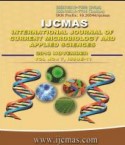


 National Academy of Agricultural Sciences (NAAS)
National Academy of Agricultural Sciences (NAAS)

|
PRINT ISSN : 2319-7692
Online ISSN : 2319-7706 Issues : 12 per year Publisher : Excellent Publishers Email : editorijcmas@gmail.com / submit@ijcmas.com Editor-in-chief: Dr.M.Prakash Index Copernicus ICV 2018: 95.39 NAAS RATING 2020: 5.38 |
Zinc deficiency in soil is induced due to soil micronutrient depletion from intensification of cultivation, application of high analysis NPK fertilizers and lesser use of organic manure. Among the various growth factors, zinc was recognized as one of the main limiting factors of maize crop growth and yields. This hypothesis was verified by conducting an experiment on zinc deficient soil to study the response of applied zinc through soil and foliar Zn-EDTA application at two stages of crop growth. The results revealed that soil application of ZnSO4 @ 25 kg ha-1 recorded the highest grain yields (62.9 q ha-1) which was at par with soil application of ZnSO4 @ 20 kg ha-1 (61.5 q ha-1) whereas, decline in grain yield of maize was observed at higher level of zinc soil application. Among the methods of zinc application, the combination treatment of seed fortification by 0.5 % of Zn-EDTA and two sprays of 0.2 % Zn-EDTA at 5th leaf stage and tasseling stages recorded relatively highest grain yield (59.0 qha-1) when compared to seed fortification and foliar application alone. Soil application of Zn explicitly influenced the Zn uptake by maize crop. The significantly highest Zn uptake was recorded by treatment application of ZnSO4 @ 25 kg ha-1 (545 g ha-1) which was at par with treatment, application of ZnSO4 @ 20 kg ha-1 (532 g ha-1). The accumulation of DTPA extractable Zn in the soil varied considerably within the treatments. Significant higher accumulation of DTPA extractable Zn was recorded by soil application of ZnSO4 @ 30 kg ha-1 (0.43 mg kg-1) which was statistically at par with soil application of ZnSO4 @ 25 kg ha-1 (0.42 mg kg-1). The zinc fractions did not show much variation however, treatment receiving zinc through soil application showed increased concentration of Zn fractions versus other methods of zinc fertilization. In general, application of 30 kg ZnSO4 ha-1 recorded higher concentration but no distinct trend was observed. The highest concentration of WS-Zn (0.17 mg kg-1), S-Zn (0.08 mg kg-1) CA-Zn (0.25 mg kg-1) was recorded by application of 30 kg ZnSO4 ha-1. RES-Zn emerged as a dominant Zn fraction followed by OM-Zn. The Zn fractions were positively and significantly correlated with DTPA-Zn and Zn uptake and also exhibited positively and significantly correlated with each other.
 |
 |
 |
 |
 |